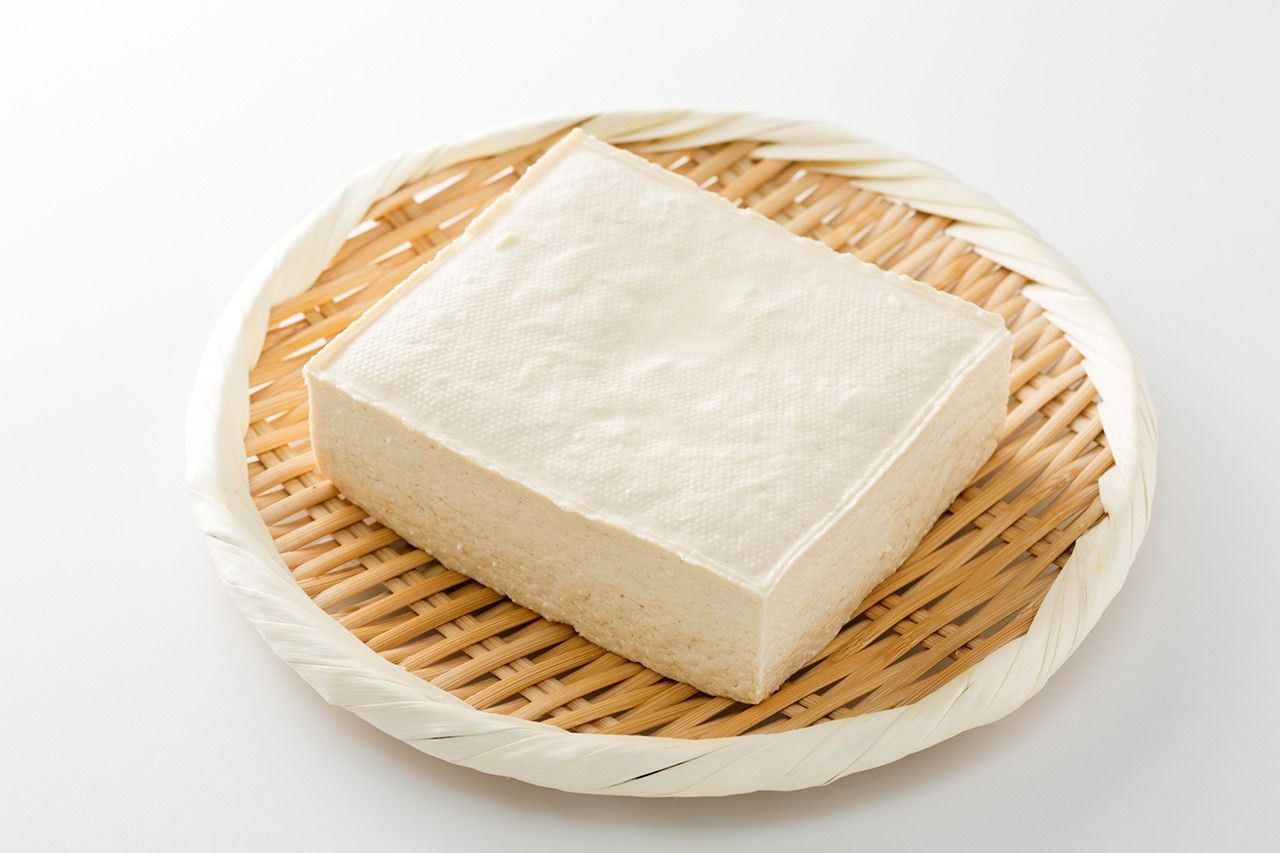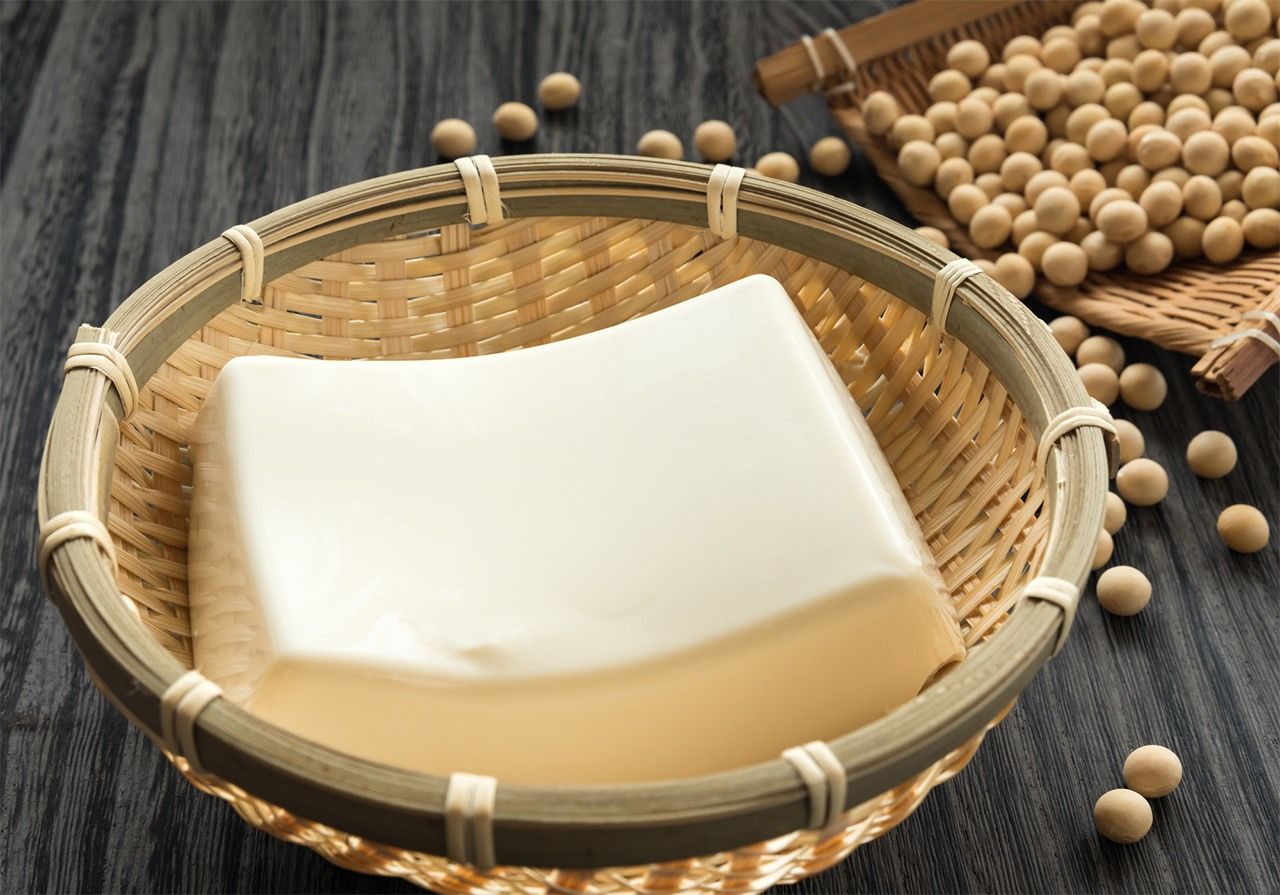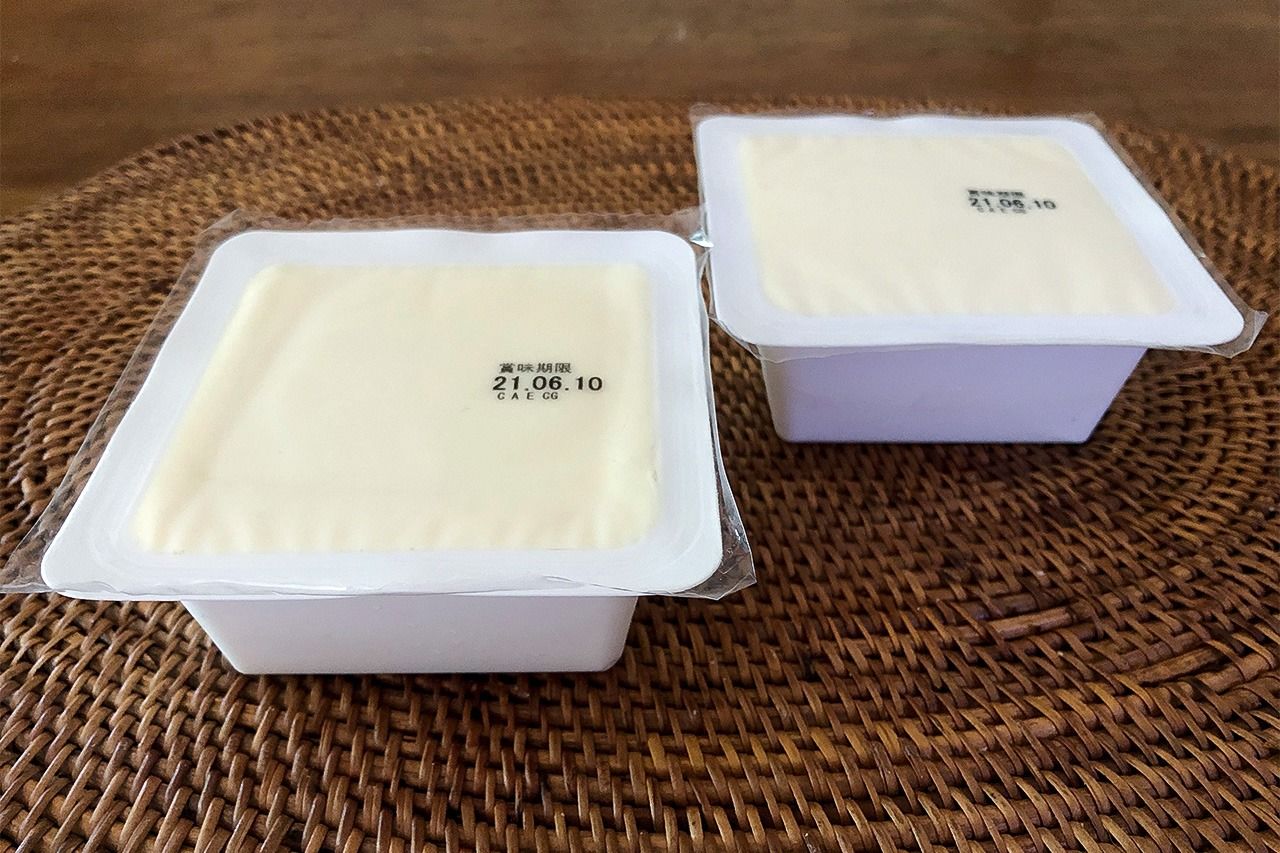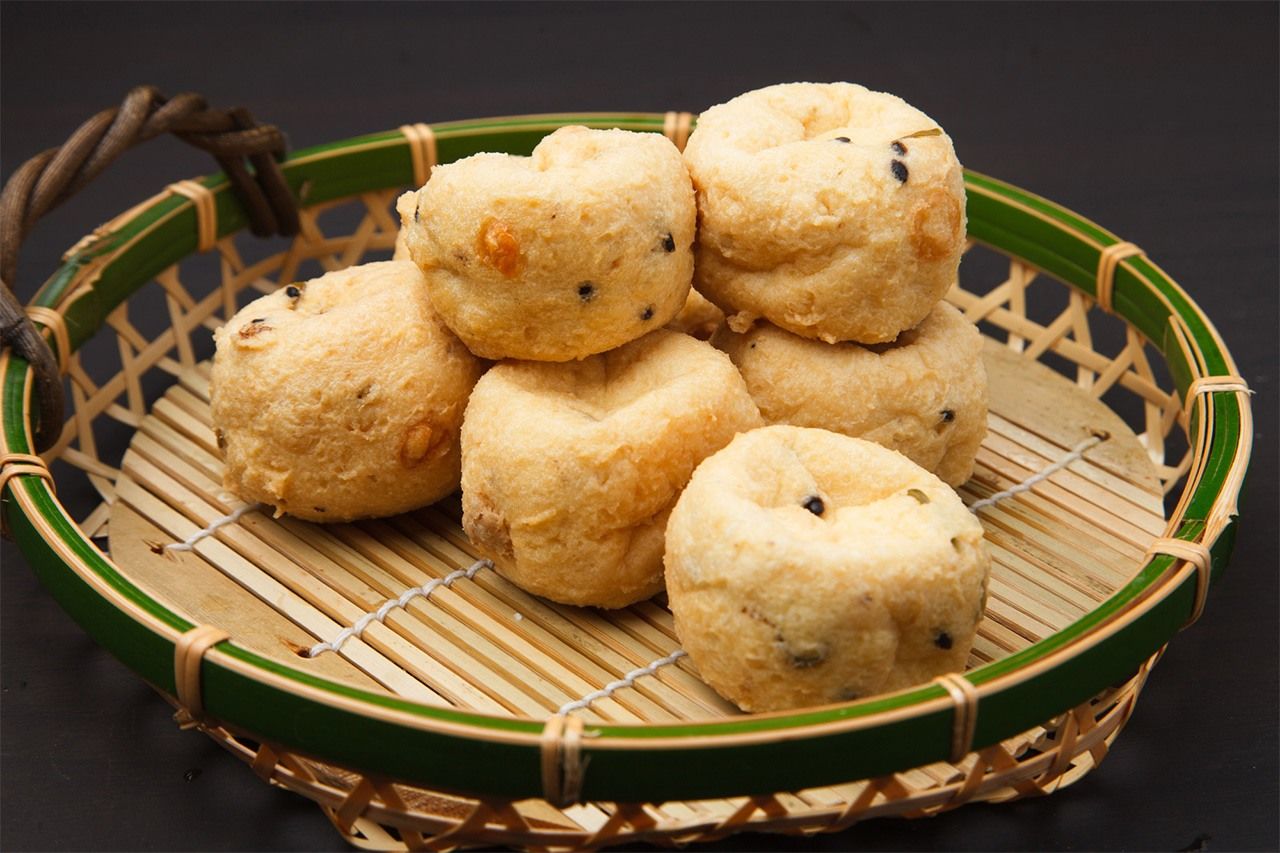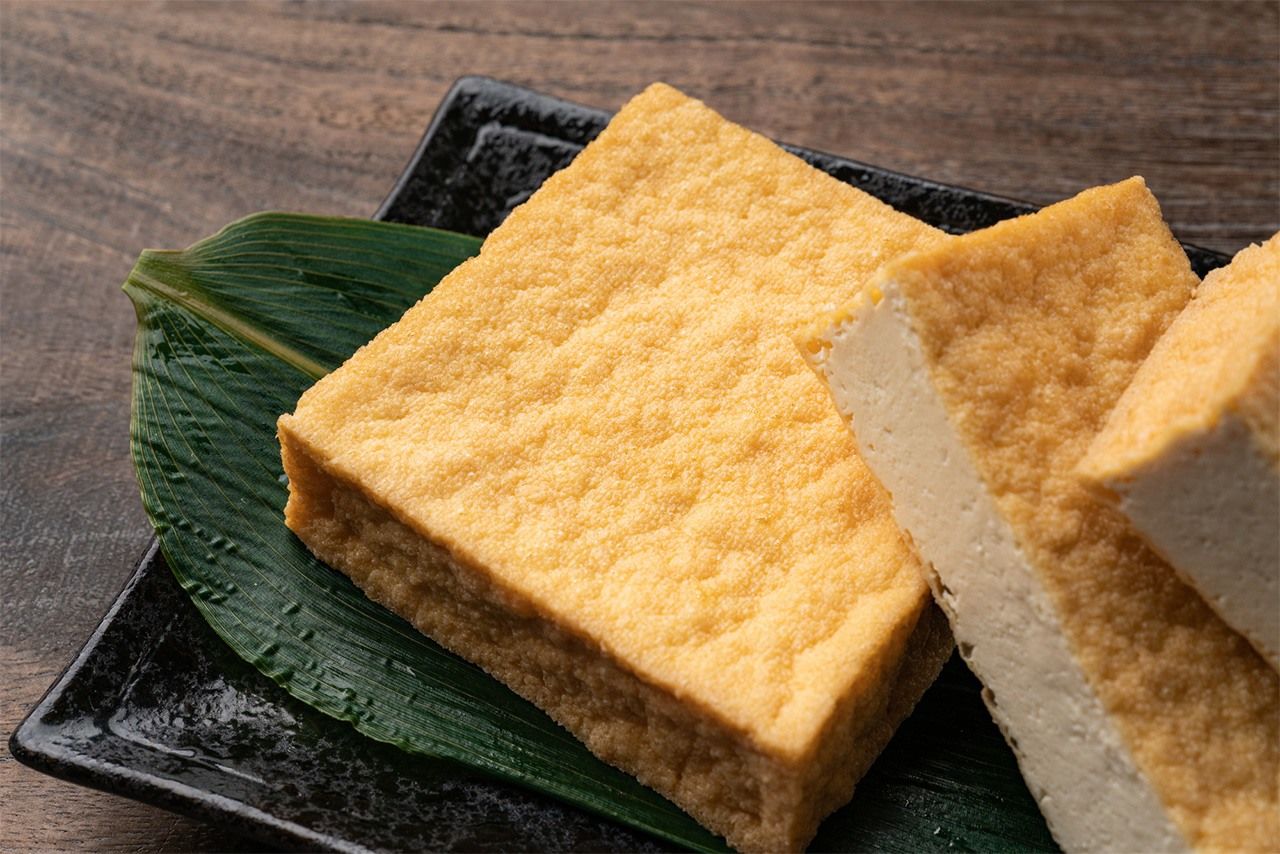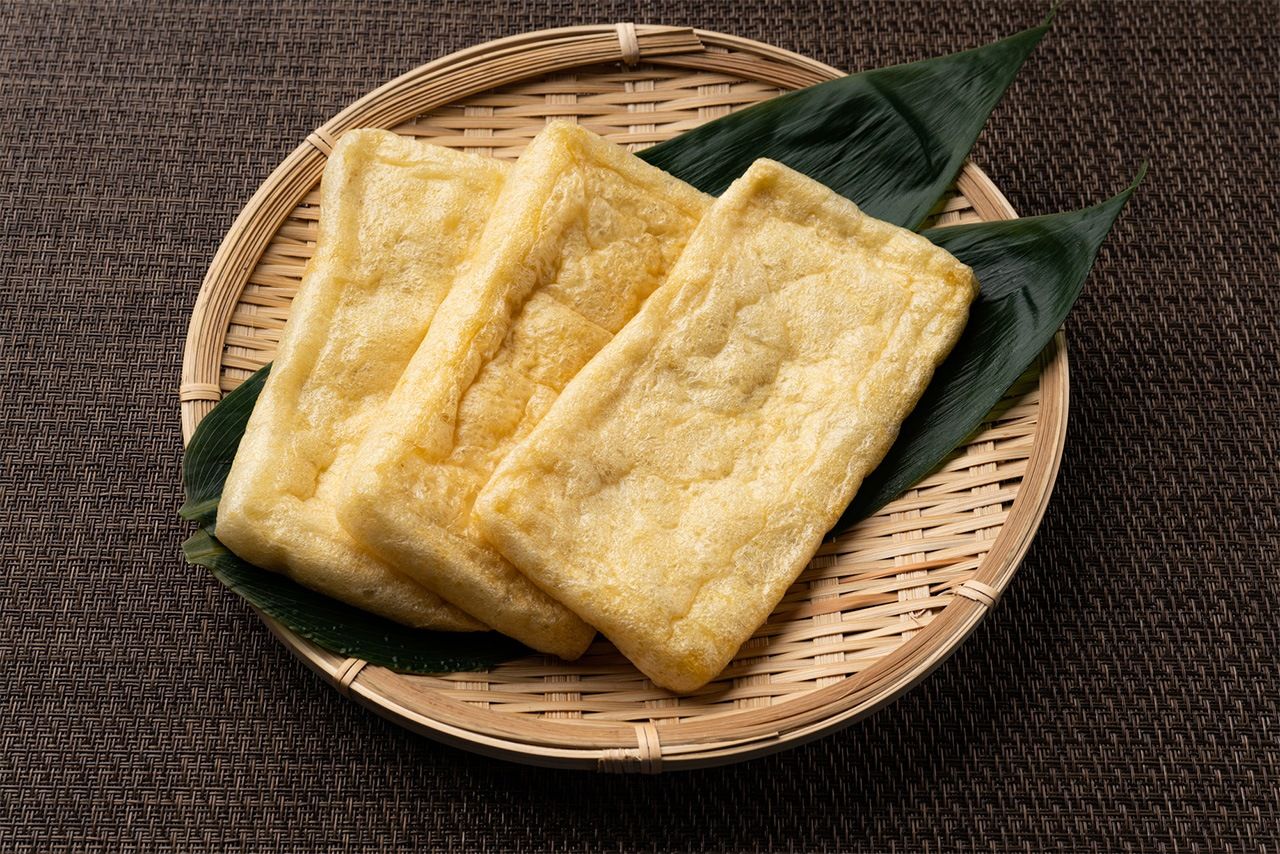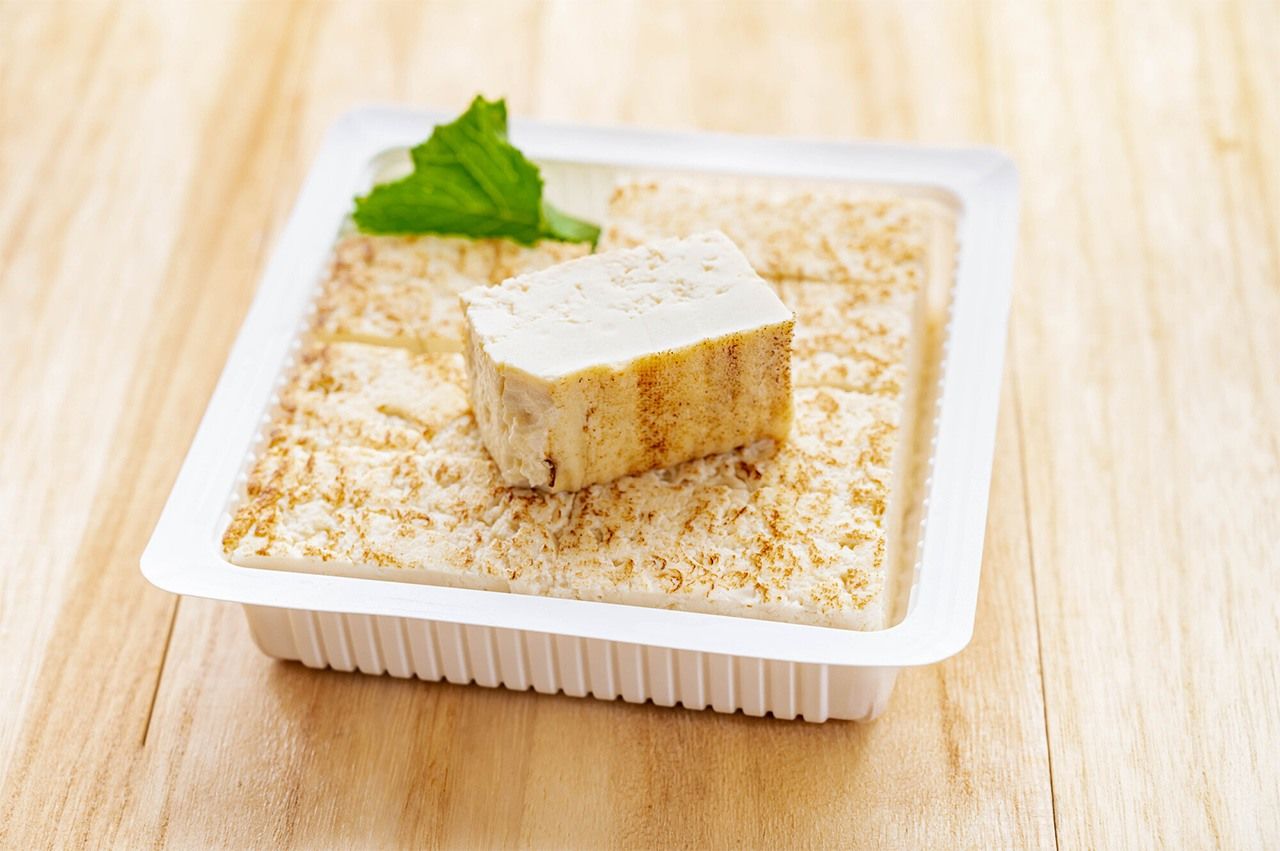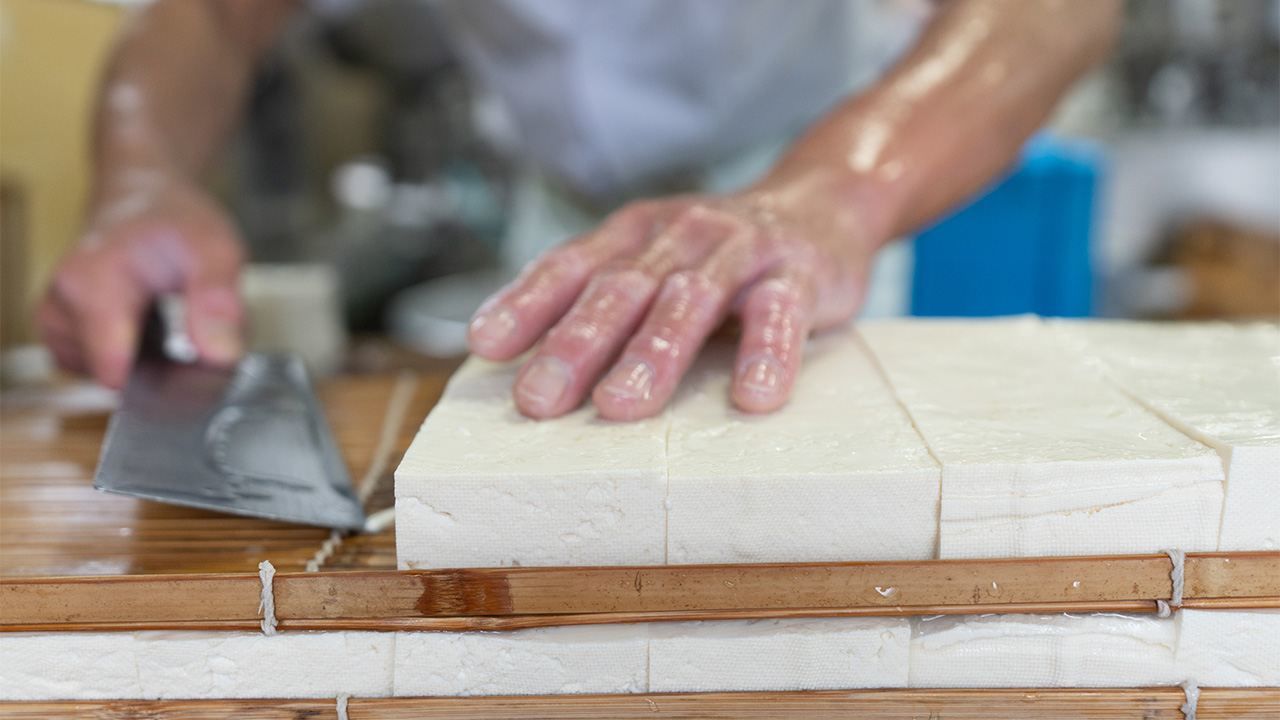
Japanese Tōfu
Culture Food and Drink- English
- 日本語
- 简体字
- 繁體字
- Français
- Español
- العربية
- Русский
Tōfu makers are early risers. Kameda Masaru is the third generation head of Tochigiya, a 91-year-old tōfu shop in Zushi, Kanagawa Prefecture, and he gets up to head into the workshop at four in the morning every day. He starts each workday by adding water to a vat of already-soaking domestically grown soybeans that he sorted and prepared the day before.
To make tōfu, he mechanically blends cooked beans into a smooth consistency, strains and heats the mixture to make soymilk, and adds the solidifying agent nigari, a mineral-rich salt obtained from seawater. He controls the resulting style of tōfu by reducing the amount of water added or by adjusting the heating or coagulation techniques. Japan alone has over 400 different types of soybeans, and tōfu made from them can range from firm, heavy styles to soft ones that can be almost drunk.
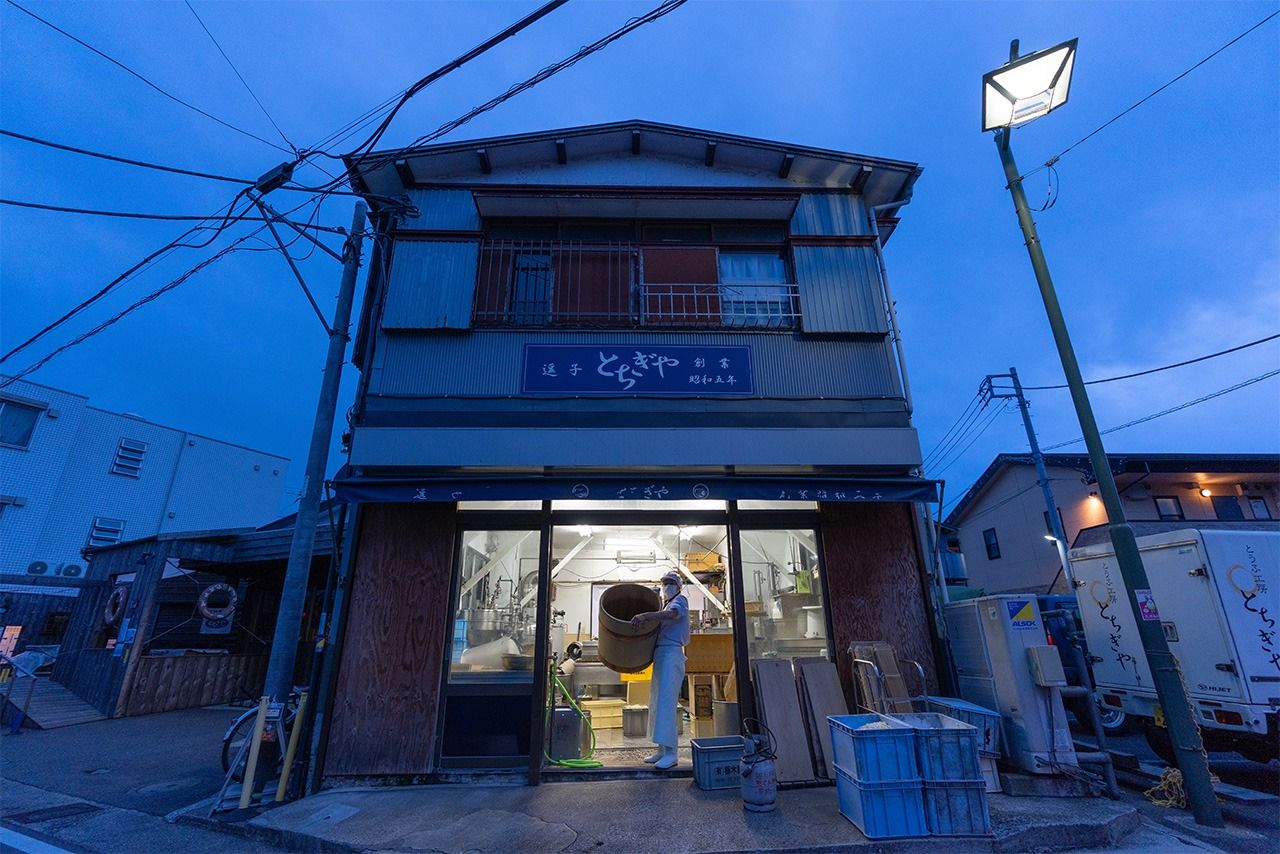
Morning at tōfu shop Tochigiya. (© Benjamin Parks)
Vegetarian Cuisine for Monks
There are many theories about how tōfu made its way to Japan. The most popular explanation is that monks and scholars travelling to China as envoys during the Nara period (710–794) and Heian period (794–1185) brough it back with them.
The kanji for tōfu, 豆腐, is written with characters meaning “bean” and “spoil,” leading to something of a misnomer in Japanese. However, in Chinese, the second character is also used to describe things that are soft and jelly-like, so the name actually means “soft beans” rather than spoiled or fermented.
In the Kamakura period (1185–1333), Buddhist monks who were vegetarian due to following a doctrine of not taking life began using tōfu as a protein supplement. As of the beginning of the Edo period (1603–1868), the common classes still considered tōfu a luxury, and it did not become widely consumed until the middle of this period. According to the Japan Tōfu Association, its spread was helped along by the publication in 1782 of Tōfu Hyakuchin, a best selling recipe book describing 100 different types of tōfu dishes prepared, in addition to eating uncooked, using techniques like simmering, steaming, boiling, grilling, frying, and stir-frying. A follow-up to the work was soon released, and together the two books offered cooks and homemakers a selection of 240 tōfu dishes to choose from, further entrenching the food into Japanese culinary culture.
Eating meat in Japan was relatively uncommon before the Meiji era (1868–1912), so tōfu gained popularity with the masses as a rich source of protein. Austrian botanist Friedrich Haberlandt encountered soybeans at the 1873 world’s fair in Vienna and analyzed samples from Japan and China. The results encouraged him to name tōfu “the meat of the fields.”
Soybean Healthiness
Soybeans and tōfu are full of nutrition. According to the 2020 edition of the Standard Tables of Food Composition in Japan published by the Ministry of Education, Culture, Sports, Science, and Technology, a 100-gram serving of soybeans contains 35.3 grams of protein while 100 grams of tōfu contains 11.2 grams of protein, roughly the same as one egg. Tōfu also contains a variety of health-promoting substances, including lecithin, which can stimulate the brain to improve memory and concentration as well as help prevent memory loss and brain aging, the antioxidant saponin, and isoflavone, which is believed to be effective in preventing breast cancer and arteriosclerosis.
Making Tōfu
Tōfu has only three ingredients: soybeans, water, and nigari (other firming agents include magnesium chloride and sumashiko, or calcium sulfate). The way these are combined determines the variety of tōfu. In the video below, Kameda demonstrates the different production processes used at Tochigiya since its founding.
(Filmed by Benjamin Parks)
First, the beans are carefully sorted and soaked in water overnight. More water is added and the soybeans are ground into a thin paste and heated to help pasteurize the mixture. Next, the paste is filtered through a cotton cloth to separate the okara, or bean curd lees, from the soymilk.
To make firm momen tōfu, nigari is mixed into the soymilk. Once the tōfu has hardened, it is broken up, spread evenly over a cotton cloth in a perforated mold, and covered and weighted to press out excess water. Once it has reached the desired firmness, it is taken from the mold and put into a tank of water to cool.
To make soft kinugoshi tōfu, a more concentrated variety of soymilk is poured into a non-perforated mold or other vessel, mixed with nigari, and allowed to harden slowly. The resulting tōfu is not pressed or drained so that it remains moist and soft.
Making Tōfu is a Dance with Nature
Kameda says that the most difficult part of making tōfu is optimizing the process in response to seasonal fluctuations in things like water temperature and the freshness of the soybeans.
Currently, he mainly uses Tsukui Zairai Daizu, a domestic heirloom variety preserved by a local farmer, but has recently discovered another domestic strain known as Tanoroku-mame. These soybeans are marked by assertive sweetness, making them very attractive for use in tōfu, and Kameda is now working with farmers to research growing methods. He aims to settle on a growing method before the company’s 100th anniversary so he can make tōfu using only these local soybeans.
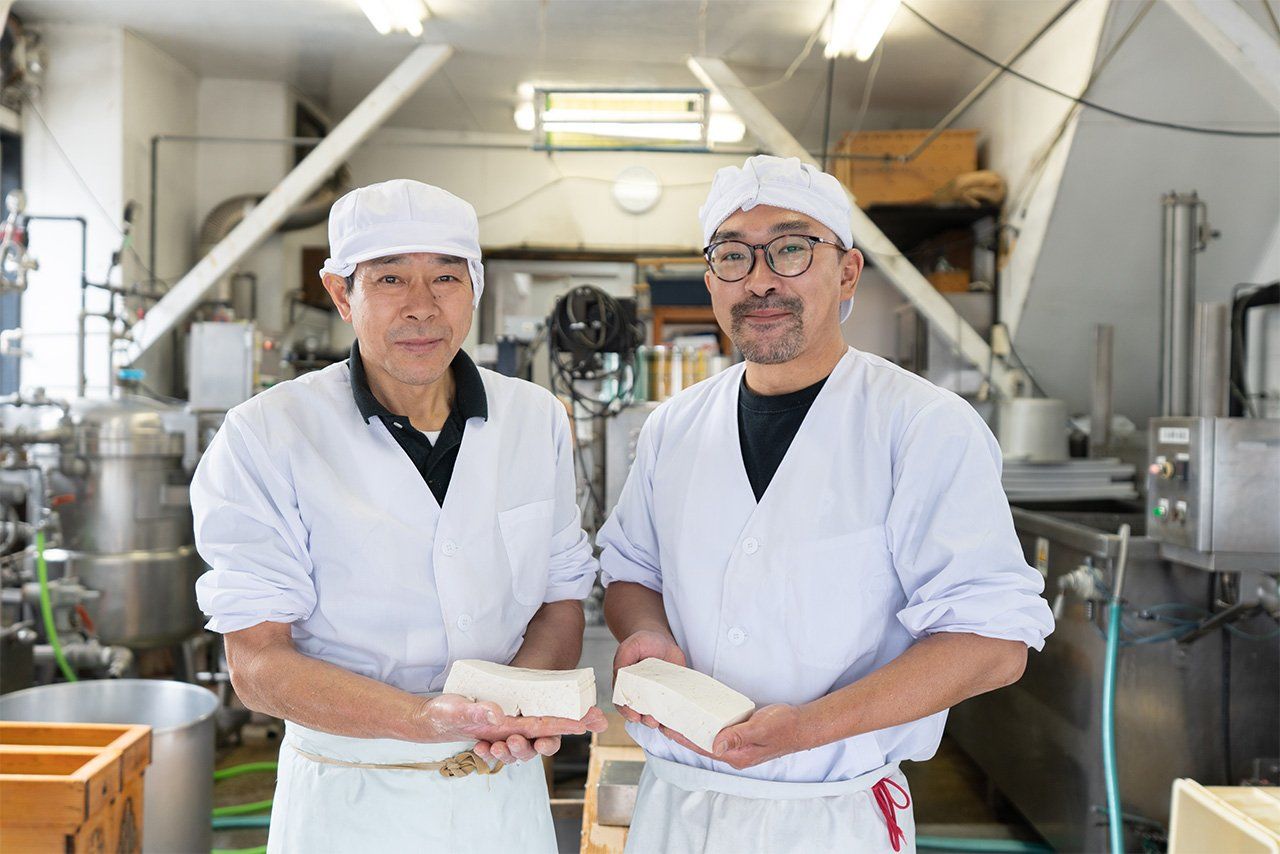
Kameda Masaru (left), third generation head of Tochigiya, with his successor, Kameda Hiroshi. (© Benjamin Parks)
Tōfu Galore
Momen tōfu
Momen tōfu has a firm, solid texture, a somewhat coarse composition, and a rich flavor. It is good for grilling, boiling, or stir-frying.
Kinugoshi tōfu
Kinugoshi tōfu has a fine-grained structure and a smooth, soft texture. It is suited to salads or can be eaten as-is, topped with soy sauce, ginger, spring onions, or other flavorings in the dish hiyayakko.
Jūten tōfu
Jūten tōfu has a softness similar to kinugoshi, but has a longer shelf life. It is made by combining cold soymilk with solidifying agent in a container that is then sealed and heated, allowing the tōfu to harden. The reduced contact with the surrounding air allows it to keep longer.
Oboro tōfu (Yose tōfu)
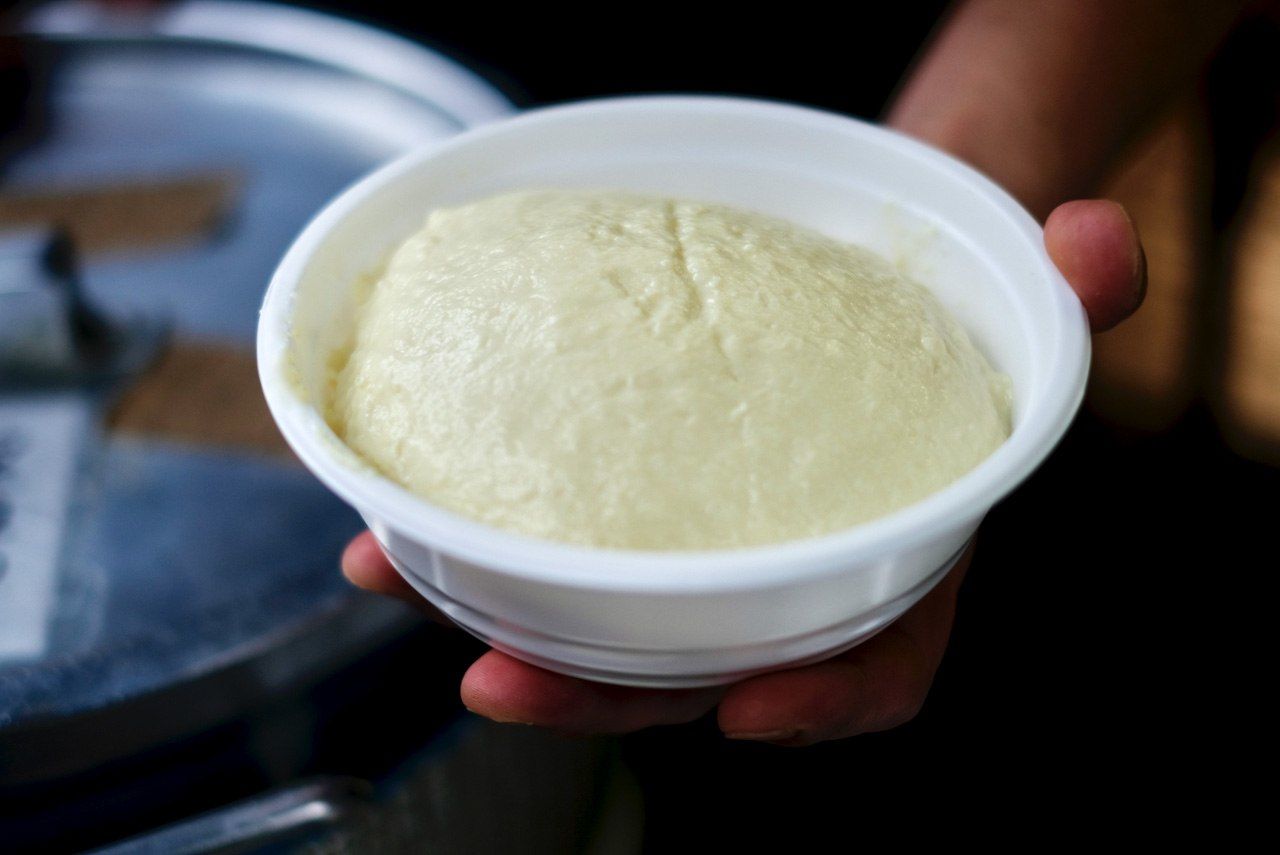
(© Kudō Shiori, with cooperation from Tōfushi Mishimaya)
Oboro tōfu is not stored in water, enhancing the natural soybean aroma and flavor. It can be eaten as-is, or used in soups. It is made in a similar way as momen tōfu, but is placed in a container while still warm.
Ganmodoki
Ganmodoki is a firm tōfu that is best for grilling, boiling, or using in oden. It is made by mashing momen tōfu and removing more of its water content. It is then mixed with grated yamaimo (mountain yam) as a binder. Chopped carrots, burdock root, shiitake, or seasonal vegetables are added, then the mixture is formed into balls and fried.
Atsuage
Atsuage is used in many styles of cooking, including grilling and stewing. It is made by frying partially dried momen tōfu in oil. The variety kinuage is made using kinugoshi tōfu.
Aburaage
Aburaage is a frequent ingredient in miso soup, stewed dishes, or stuffed with sushi rice to make inarizushi. It is made from momen tōfu prepared with diluted soy milk that is then sliced thinly, dried, and deep-fried.
Grilled tōfu
Grilled tōfu holds together well and absorbs flavors, making it suited for dishes like sukiyaki and stews. It is made from particularly firm momen tōfu that is further dried before being seared with a gas flame on both sides.
Endless Versatility
There are seemingly endless ways to eat tōfu. Every season has its tōfu dish, from the hiyayakko of summer topped with your favorite herbs and soy sauce on cold tōfu, to yudōfu swimming in a hot dashi broth for winter. Tōfu can also be seasoned with salt and pepper and olive or sesame oil for a light, refreshing snack, or topped with kimchi and anchovies.
The okara lees left after straining the soymilk are also a great source of fiber. Some tōfu shops have started to offer tōfu-based snacks like donuts containing okara.

Donuts made with tōfu and okara (© Benjamin Parks with cooperation from Tochigiya)
Homemade Tōfu
Ambitious foodies can make aromatic tōfu at home from soybeans or unprocessed soy milk and nigari.
Ingredients
- Soybeans: 100 grams
- Hot water: 400 milliliters
- Nigari (undiluted): 3 grams (the concentration can differ by manufacturer, so it may require repeated adjustment)
- Water: 9 grams (to mix with nigari)
- Soak the soybeans in fresh water overnight.
- Boil the soybeans until soft and let cool to around 60°C. Mix the soybeans with an equal amount of hot water and blend together until smooth.
- Add the remaining hot water to the mixture and allow to cool.
- Strain the mixture through a cheesecloth to separate the okara from the soymilk.
- (If using unprocessed soy milk, start the process here.) Put the soymilk into a pot, stir while bringing to a boil, reduce heat to low, and simmer for five minutes. Allow to cool to 80°C.
- Using a wooden spatula, stir the soy milk in the same direction 10 times to create a current. Put in the nigari (3 grams base solution mixed with 9 grams water), stir quickly again in the same direction, and then stop the flow with the spatula.
- Turn off the heat, cover the pot, and let sit for 15 minutes.
(Excerpt from Mainichi tōfu reshipi (Daily Tōfu Recipes) by Kudō Shiori)
(Originally published in Japanese on June 19, 2021. Banner Photo: Cutting momen tōfu blocks for aburaage. © Benjamin Parks.)
